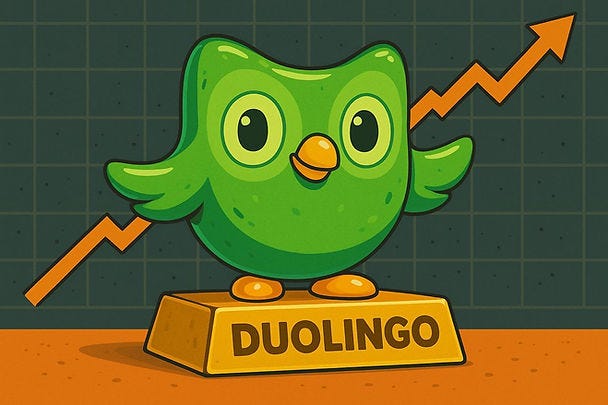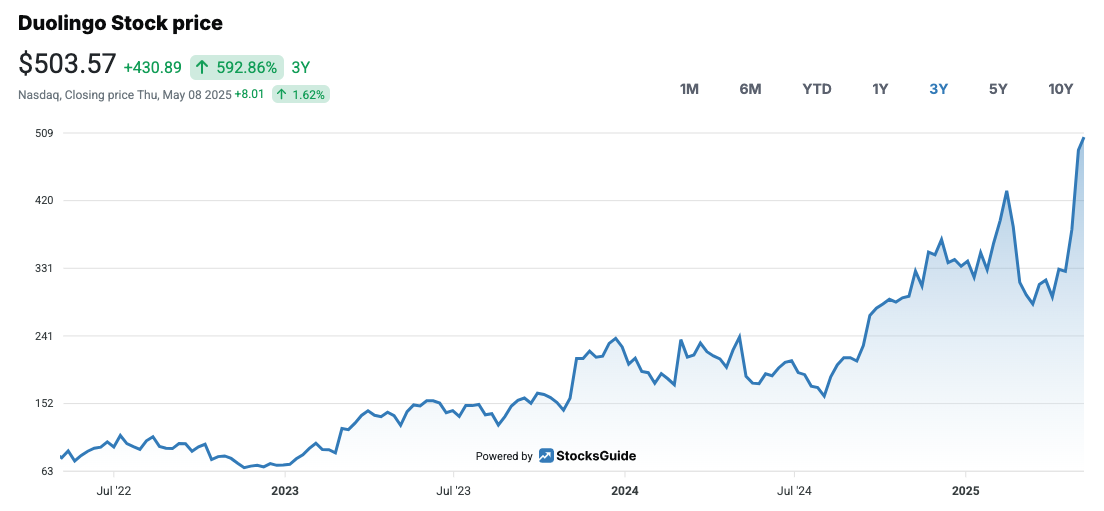Duolingo Share: What's Next After A +500% Gain?
Duolingo is growing fast - revenue, user growth, and AI innovation are impressive. But is the stock still worth buying after a +500% gain?
With my personal Spanish streak of roughly 600 days, Duolingo shares are not only an attractive investment for me, but the language learning platform has also been part of my daily routine for the past two years. I have been invested in the company since November 2022 (click here for the original investment story, unfortunately only available in German), and as a satisfied customer and happy shareholder, I always look forward to their quarterly numbers.
Duolingo ( DUOL 0.00%↑ ) once again delivered strong results in the first quarter of 2025, further solidifying its position as the leading provider of digital language learning. With 38% year-over-year revenue growth, significant user growth, and the successful application of artificial intelligence (AI), the company is setting new standards in the EdTech industry.
The quarterly results at a glance:
Duolingo's Q1 2025 Financial Highlights
Duolingo once again delivered impressive numbers for the first quarter of 2025. Revenue grew 38% organically to $230.7 million. Bookings also grew 38% to $271.6 million. Particularly encouraging was the 44% increase in subscription bookings to $232.2 million. Subscription revenue now represents 83% of total revenue.
Duolingo also saw an increase in profits. Adjusted EBITDA increased by 43% to $62.8 million (EBITDA margin: 27.2%). Net income increased by 30% to $35.1 million, representing diluted earnings per share of $0.72. Free cash flow also developed positively, increasing 31% to $103.0 million, representing a free cash flow margin of an impressive 44.5%. The slight decline in the FCF margin from 46.8% in the prior year was due to higher operating costs for the new AI features.
These figures significantly exceeded analysts' expectations and caused Duolingo's share price to rise by more than 20% to a new all-time high.
Rapid User Growth
Duolingo's user base continued to grow significantly in the first quarter of 2025. Daily active users (DAUs) increased by 49% to 46.6 million. Monthly active users (MAUs) rose by 33% to 130.2 million. The number of paying subscribers was particularly encouraging, growing 40% to 10.3 million.
This shows that Duolingo is not only attracting new users, but also increasing their engagement and converting more and more of them into paying subscribers.
The secret to Duolingo's success lies in its successful gamification elements. Many users (like me) are playfully driven to keep their "streaks" as long as possible and stay on track every day in "competition" with friends or family on Duolingo.
One of the reasons for the user growth last quarter was the (almost) free "Dead Duo" marketing campaign, which was told as a "whodunit" story on social media. It announced that the mascot Duo had died, accompanied by black and white images and messages of grief. The app took on a somber design and urged users to practice diligently to "bring Duo back to life". This generated 1.7 billion organic impressions and brought new - as well as "old" - users to the platform.
Competitive Landscape And Market Position
Duolingo is successfully standing its ground against competitors such as Babbel, Rosetta Stone and Memrise. With over 10 million paying subscribers and a strong brand presence supported by viral marketing campaigns, the company is consolidating its currently unchallenged market leadership.
The combination of a freemium business model, continuous product innovation and an active community creates high barriers to entry for new competitors.
Recently, there has been discussion about possible new competition for Duolingo from ChatGPT or Google's "Little Language Lessons". These are a collection of experimental AI-based learning modules based on the Gemini models. Different modules are designed to make language learning more personalized and practical. These tools are intended as supplemental learning aids, not as complete language courses. They aim to make learning more interactive and contextual.
Currently, Duolingo's success story is not expected to be disrupted by existing direct competitors or by generalist AI tools such as ChatGPT or Gemini. But who knows how these tools will evolve in 3 or 5 years.
The only thing that is certain is that online tools like Duolingo will capture an increasing share of the huge language learning market over time. The total value of the global language learning market is estimated to be around $220 billion in 2025. This figure includes both online and offline learning. Although the online language learning market is growing rapidly at around 20% per year, the revenue in this segment is estimated to be only around $23 billion in 2025.
This means that about 90% of the market is still in the offline segment, so the biggest competitor to online tools like Duolingo remains the traditional language course with a human language teacher. In other words, there is still a lot of growth potential for several digital AI players in the future. Duolingo is likely to be one of them.
Product Development And Innovation
In 2025, Duolingo will continue to focus on AI to drive the growth of the platform. A key component of this is Duolingo Max, the relatively new premium version with AI-powered features. One of the most popular features is video calling with a character named Lily. Users can talk to Lily in a fun environment and practice their language skills.
The Duolingo management now plans to render Lily and her environment in 3D. Interactive backgrounds and more realistic animations will also be integrated to make the conversations even more intense and engaging. The goal is to make Duolingo Max even more attractive and to increase users' willingness to pay.
At the same time, the company is using generative AI to scale the creation of learning content more quickly. In the first quarter, this enabled the launch of nearly 150 new language courses - a record. The AI-generated courses make it possible to efficiently and quickly expand content to new languages and regions.
Another highlight: Duolingo announced the launch of a chess course. This expands the platform's learning offerings beyond languages, math and music to include games that require strategic thinking and problem solving. The targeted audience is users who enjoy learning through play. The course will cover everything from the basics of chess to tactical exercises against a virtual coach.
AI As A Driver Of Both: Growth And Cost
Management sees great opportunities in the field of generative AI (GenAI) to enhance and create new features such as role-playing games and individual learning paths. However, the increasing use of AI is also associated with high costs. As a result, margins declined slightly in the first quarter compared to the same period last year. However, Duolingo was able to implement first cost optimizations in the first quarter, which had been planned for the second quarter. Among other things, the models for the role-playing games were adjusted, which significantly reduced the operating costs for these features.
Further efficiency improvements are planned for the second quarter. According to management, experience with the measures already implemented shows that the cost per AI interaction can be reduced sustainably without compromising quality.
Valuation Of The Duolingo Share
Based on a share price of $500 USD, Duolingo's enterprise value (EV) is approximately at $22 billion USD. This results in the following valuation metrics:
Based on the trailing 12 months, the P/E ratio is over 200 and the enterprise value to free cash flow ratio (EV/FCF, simply explained here) is 75. The EV/Sales (TTM) ratio is 27. Duolingo shares therefore seem extremely expensive, even by historical standards.
Due to the rapid growth of the company, these multiples look very different when we look further into the future:
Based on the full year 2025 revenue forecast (just under $1 billion USD), the EV/FCF ratio is estimated at approximately 44, based on expected free cash flow generation of approximately $400 million USD. The EV/sales ratio is 21.
These high multiples show that the market believes Duolingo will continue to grow strongly and maintain its dominant market position. At the same time, the stock is very aggressively valued and susceptible to major setbacks.
Conclusion
Duolingo is doing very well and has regularly exceeded expectations for years. This is now reflected in the share price. Due to its high valuation, Duolingo is one of the most speculative stocks in my portfolio. Since I bought it three years ago, the share price has more than quintupled. Although I have already taken some profits, the stock is currently one of the larger positions in my private portfolio.
If you are interested in the Duolingo stock, I would advise you to wait for a major pullback before investing, as this is a highly volatile stock. In a negative market environment, a stock like this can quickly lose half its value, even if the company continues to perform well. You should therefore consider taking (partial) profits from time to time if you have been a proud Duolingo shareholder for years, as I have.
If you would like to follow Duolingo's future development with me, you can subscribe to my free newsletter here:
*Disclaimer: The author and/or related persons or companies own shares in Duolingo. This article is an expression of opinion and does not constitute investment advice.







Thanks for the read. I wrote about Duolingo when shares were $270. Not sure why I didn't buy. Guess shares back then were expensive while now they're extremely expensive